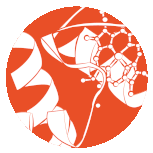
OK Ada—what next? @jennifergardy has some answers
 As an antidote to all the women in STEM doom and gloom, Dr. Jennifer Gardy, one of our personal Ada Lovelace Day nominations, has some calls to positive action. “Focus on the positive,” she advised a packed audience at SFU’s Ada Lovelace workshop last month. “It will get better.”
As an antidote to all the women in STEM doom and gloom, Dr. Jennifer Gardy, one of our personal Ada Lovelace Day nominations, has some calls to positive action. “Focus on the positive,” she advised a packed audience at SFU’s Ada Lovelace workshop last month. “It will get better.”
Then she presented her observations, and explained her optimism.
Pulling student and faculty data from SFU’s website, Gardy pointed out that although traditional male-dominated hard science areas such as applied science fields are still disproportionately gender biased from grad students upwards, life sciences are approaching gender parity. And with historical data gleaned from yearbooks in the mid-sixties, she showed that this gender disparity was also the norm for life sciences way back then. Moreover, taking a peek at the PhDs awarded per subject and analyzing them on a percentage basis, even applied sciences such as physics are showing an increase in women gaining these higher degrees.
It will take time, but eventually the wave of increasing gender parity that’s starting among grad student numbers will come crashing onto the shore of faculty staffing levels.
Acknowledging the “leaky pipeline” portrayal of women in academia, where the higher up the career ladder you look, the more women have apparently dropped out, Gardy advises us to stay tuned for the exponential growth in numbers of women advancing upward in these areas.
But apart from waiting for the wave to hit the shore, what else can we do to improve numbers of women advancing through STEM careers?
For one thing, Gardy advises encouraging girls and women to take up STEM careers: from kids in high school through to young adults just starting out, all need encouragement. She herself credits the amazing mentors, both men and women, who guided her along the way, and feels that all of us can do our little bit no matter how senior or junior we feel.
But instead of focusing on the negative news, try to spread positive images of women in STEM; no one wants to go into a field where six out of ten hits in a Google search page deal with gender-directed awfulness. Although she admits that as a woman in STEM in general, and broadcast science communication in particular, the path isn’t easy, Gardy believes there’s a lot of positivity that can be pushed to the front.
Another positive action point is that we should all recognize bias when we meet it, and call it out to promote gender equality in the workplace. Gardy gave the example of Jonathan Eisen’s #YAMMM hashtag on Twitter, where he (@phylogenomics) calls out Yet Another Mostly Male Meeting, and what’s more, calls out to the speakers to reconsider their involvement.
Hey @markgerstein I would suggest you withdraw from this meeting w/ such a biased gender ratio of speakers http://t.co/VP0KrpXWot
— Jonathan Eisen (@phylogenomics) October 14, 2014
Other examples given by Gardy included recognizing personal biases that automatically consider males more qualified in science—apparently it’s inherent in most of us. Companies such as IT giant Google are acknowledging this and taking steps to avoid this in their hiring and promotion processes. Another initiative in development is the United Kingdom’s Athena Swan charter mark, which looks at workplace equality issues. Charter mark status might be an important consideration in future grant awards, perhaps?
Finally, Gardy suggested that we as women in STEM can also help ourselves. She suggested investing in executive coaching to develop management and workplace-related skills to aid presentation skills, confidence and more.
Gardy’s Ada Lovelace presentation was a welcome blast of optimism for women in STEM careers. Though there is still a long way to go before gender parity is achieved, the tide is certainly turning. There’s a lot to be hopeful for.

No Comments